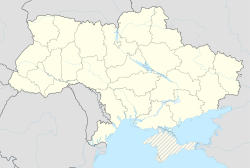Sielec, Drohobych Raion
|
Selets Селець |
|
|---|---|
| Village | |

Church of the Theotokos and cemetery in Selets
|
|
| Location of Selets in Lviv Oblast, western Ukraine | |
| Coordinates: 49°27′0″N 23°18′0″E / 49.45000°N 23.30000°ECoordinates: 49°27′0″N 23°18′0″E / 49.45000°N 23.30000°E | |
| Country |
|
| Oblast |
|
| Raion |
|
| Founded | around 1430 |
| Government | |
| • Village Head | Volodymyr Kravets |
| Area | |
| • Total | 0.021 km2 (0.008 sq mi) |
| Elevation | 342 m (1,122 ft) |
| Population (2001) | |
| • Total | 164 |
| Time zone | EET (UTC+2) |
| • Summer (DST) | EEST (UTC+3) |
| Postal code | 82123 |
| Area code(s) | +380 3244 |
| Website | Sielec on the Verkhovna Rada of Ukraine website |
Selets (Ukrainian: Селець) is a village about 13.5 kilometers southeast of Sambir within Drohobych district of Lviv province in western Ukraine. The village was founded probably in the 15th century CE.
To the north lies the village and forest of Side (), to the east Horodyshche (), to the south Mokriany () and to the west Vilshanyk (). Geographically, the area lies in the Dniester river basin, to which the Bystrytsia () and Cherkhavka () rivers are tributaries.
Together with the villages of Kotovane () and Stupnytsia (), it administratively forms a local village council.
The village was first mentioned in 1538 in a document from 1559. King Michał Korybut Wiśniowiecki established the parish between 1669 and 1673, during which time a royal church was constructed. Another church with its own parish for the local Polish-speaking nobility (szlachta) was built later; both parishes coexisted before they later merged.
While the area was crown property, the Dżurdż family was given half of it at an unknown date. Around 1650 King John II Casimir awarded the Cossack Ataman Skrebeciowicz the other half of the Sielec estate, as well as the right to bear the Sas coat of arms for his loyal services to the crown during the Khmelnytsky Uprising. After the Austrian partition of southern Poland in 1772, the Skrebeciowicz de Sielecki family’s noble status was reaffirmed by the imperial court in Vienna who gave it the hereditary German title of Ritter.
...
Wikipedia

